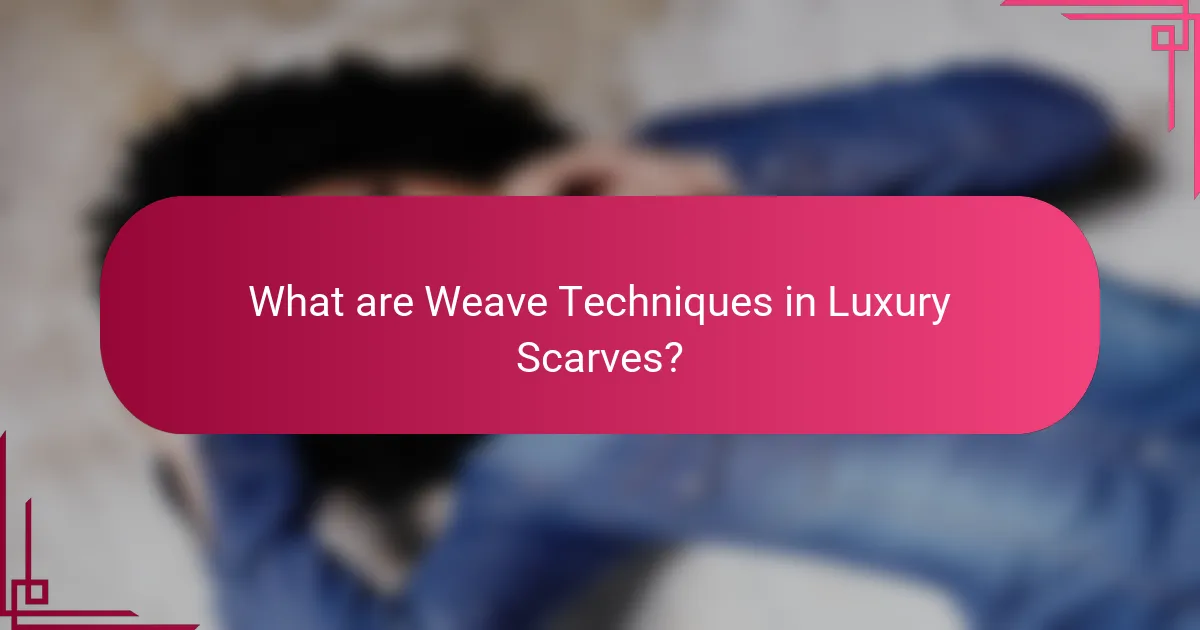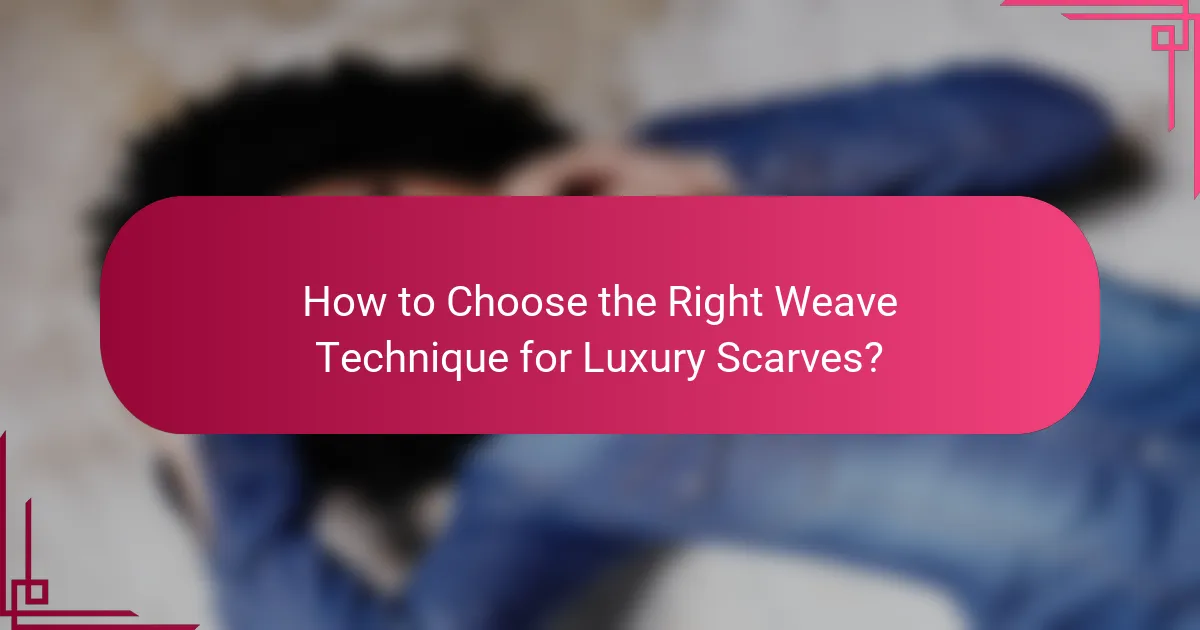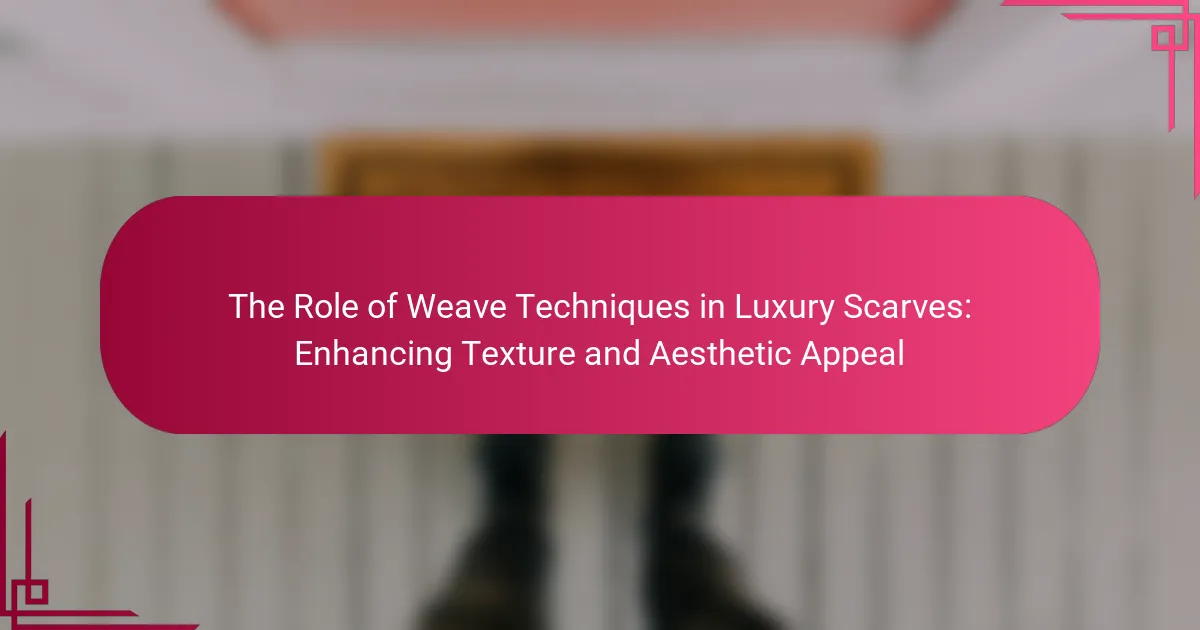Weave techniques in luxury scarves are essential methods for interlacing threads to create fabric, significantly influencing the texture, aesthetic appeal, and overall quality of the scarves. Common techniques include twill, satin, and plain weave, each offering unique characteristics such as durability, glossiness, and simplicity. The choice of weave impacts how the scarf drapes and feels, with specific weaves catering to different materials like silk, cashmere, and wool. Additionally, the intended use of the scarf, whether for formal occasions or casual wear, plays a crucial role in selecting the appropriate weave technique, ensuring that the final product meets the desired aesthetic and functional requirements.

What are Weave Techniques in Luxury Scarves?
Weave techniques in luxury scarves refer to the specific methods used to interlace threads to create fabric. Common techniques include twill, satin, and plain weave. Twill weave produces a diagonal pattern, enhancing durability and texture. Satin weave results in a glossy surface, providing a luxurious feel. Plain weave is the simplest method, offering a balanced structure. Each technique influences the scarf’s drape, texture, and visual appeal. For instance, silk scarves often utilize satin weave for its sheen. The choice of weave impacts the overall aesthetic and quality of the scarf.
How do different weave techniques impact the texture of luxury scarves?
Different weave techniques significantly impact the texture of luxury scarves. Techniques such as jacquard and twill create distinct tactile experiences. Jacquard weaving produces intricate patterns, resulting in a textured surface that enhances visual depth. Twill weaving, characterized by its diagonal pattern, offers a softer, more fluid feel.
Each technique affects how light interacts with the fabric. For example, satin weave results in a glossy finish, contributing to a luxurious handfeel. Conversely, a plain weave provides a more structured texture, often perceived as crisp and durable.
The choice of weave directly influences the drape and overall aesthetic of the scarf. High-quality fibers, when combined with advanced weaving methods, elevate the scarf’s luxury appeal. This relationship between weave technique and texture is essential in luxury fashion, where tactile experience is paramount.
What are the most common weave techniques used in luxury scarves?
The most common weave techniques used in luxury scarves include twill, satin, and plain weave. Twill weave creates a diagonal pattern, offering durability and a rich texture. Satin weave provides a smooth, glossy surface, enhancing the scarf’s aesthetic appeal. Plain weave is the simplest technique, known for its versatility and breathability. These techniques contribute to the overall quality and feel of luxury scarves. Twill is often used in high-end wool and silk scarves. Satin is favored for elegant evening wear. Plain weave is commonly found in lightweight summer scarves. Each technique plays a crucial role in defining the scarf’s character and luxury status.
How does the choice of weave technique affect the overall feel of the scarf?
The choice of weave technique significantly impacts the overall feel of the scarf. Different techniques create varying textures and drapes. For instance, a twill weave results in a soft, smooth finish. This technique allows for a subtle sheen, enhancing luxury. Conversely, a plain weave produces a firmer texture. It gives the scarf a more structured feel. Additionally, intricate weaves like jacquard can add depth and complexity. These techniques can create tactile interest, making the scarf feel richer. The weave also influences warmth and breathability. For example, looser weaves provide better airflow, making them suitable for warmer climates. Each weaving method thus contributes uniquely to the scarf’s tactile experience.
Why are weave techniques important for aesthetic appeal in luxury scarves?
Weave techniques are crucial for the aesthetic appeal of luxury scarves. They determine the texture, pattern, and overall visual impact of the fabric. Different techniques, such as twill or satin, create distinct surface qualities. For example, satin weaves produce a smooth, glossy finish that enhances color vibrancy. In contrast, twill weaves offer a more textured appearance, adding depth to the design. The choice of weave influences how light interacts with the scarf, affecting its perceived richness. High-quality weaves also signify craftsmanship, elevating the luxury status of the scarf. Thus, weave techniques directly contribute to the luxury and aesthetic experience of the product.
How do weave techniques contribute to the visual design of scarves?
Weave techniques significantly influence the visual design of scarves. Different weaving methods create distinct patterns and textures. For example, jacquard weaving allows for complex designs and intricate motifs. This technique enhances the visual appeal by integrating various colors and shapes. Additionally, twill weaving produces diagonal patterns, contributing to a sophisticated look. The texture created by these techniques affects how light interacts with the fabric. Textured scarves can appear more dynamic and visually interesting. Overall, the choice of weave technique plays a crucial role in defining a scarf’s aesthetic.
In what ways do different textures enhance the aesthetic value of luxury scarves?
Different textures enhance the aesthetic value of luxury scarves by providing visual interest and depth. Textures can create a tactile experience that draws attention. For instance, silk offers a smooth, glossy finish that reflects light beautifully. This reflection adds an element of luxury and elegance. Conversely, cashmere presents a soft, matte texture that conveys warmth and comfort. The contrast between these textures can elevate the overall look of a scarf. Additionally, intricate weaves, such as jacquard or twill, introduce patterns that enhance visual complexity. These patterns can make a scarf more distinctive and fashionable. Ultimately, the combination of various textures contributes to the unique appeal of luxury scarves.

What are the Benefits of Various Weave Techniques?
Various weave techniques enhance the texture and aesthetic appeal of luxury scarves. Different weaves create unique patterns and visual effects. For instance, satin weave produces a smooth, glossy surface, which adds elegance. Twill weave offers a diagonal pattern, providing durability and a rich texture. Jacquard weaving allows intricate designs, elevating the artistic value of the scarf. Each technique affects the drape and feel, influencing how the scarf interacts with the wearer. Additionally, specific weaves can enhance warmth or breathability, catering to different climates and preferences. Overall, the choice of weave significantly impacts the overall quality and desirability of luxury scarves.
How do weave techniques influence the durability of luxury scarves?
Weave techniques significantly influence the durability of luxury scarves. Different weaving methods create varying levels of density and strength in the fabric. For example, a tight weave enhances the fabric’s resilience against wear and tear. Conversely, a loose weave may lead to quicker fraying and damage.
Materials used in weaving also play a crucial role. Natural fibers like silk and wool can be woven to produce durable textiles. In contrast, synthetic fibers may offer different durability characteristics based on their weave.
Additionally, specialized techniques like jacquard weaving can create intricate patterns while maintaining structural integrity. This balance of aesthetics and function is essential for luxury scarves.
Research indicates that the choice of weave can affect longevity. A study published in the Journal of Textile Science found that tighter weaves significantly reduce fabric abrasion. Therefore, the selection of weave technique is vital in ensuring the durability of luxury scarves.
Which weave techniques provide the best longevity for luxury scarves?
Twill and satin weave techniques provide the best longevity for luxury scarves. Twill weave creates a diagonal pattern that enhances durability. This technique allows for better fabric strength and resistance to wear. Satin weave offers a smooth finish that reduces friction, minimizing fabric damage. Both techniques maintain their shape and appearance over time. Additionally, high-quality fibers used in these weaves contribute to longevity. Research indicates that tightly woven fabrics resist fraying and fading. Thus, twill and satin weaves are ideal for luxury scarves requiring durability.
How can the choice of weave technique affect maintenance and care?
The choice of weave technique significantly impacts the maintenance and care of luxury scarves. Different weaves can determine how easily dirt and stains accumulate. For example, tighter weaves tend to repel dirt better than looser ones. Additionally, some weave techniques may require more delicate cleaning methods.
For instance, jacquard weaves may need hand washing to preserve their intricate patterns. In contrast, simpler weaves like plain or twill can often withstand machine washing. The choice of weave also influences the fabric’s durability. More complex weaves might be prone to snagging, necessitating careful handling.
Overall, understanding the weave technique helps in selecting appropriate cleaning products and methods. This knowledge ultimately extends the life and appearance of luxury scarves.
What role do weave techniques play in the luxury fashion market?
Weave techniques are crucial in the luxury fashion market as they significantly enhance the texture and aesthetic appeal of garments. These techniques determine the fabric’s quality and durability, which are vital for luxury products. For instance, intricate weaves like jacquard or twill create unique patterns and textures that elevate a scarf’s visual appeal. Luxury brands often employ these techniques to distinguish their products from mass-market offerings. High-quality weaves can also improve the drape and feel of fabrics, making them more desirable to consumers. According to a study by Fashion Institute of Technology, the craftsmanship involved in weaving directly impacts consumer perception of luxury. Thus, weave techniques play a fundamental role in defining the luxury fashion market’s standards and consumer expectations.
How do designers select weave techniques for their luxury scarf collections?
Designers select weave techniques for their luxury scarf collections based on desired texture and aesthetic appeal. They consider the material properties, such as silk or cashmere, which influence the final look. The choice of weave can enhance softness, durability, or drape. Designers also evaluate the intended use of the scarf, whether for casual or formal occasions. Historical trends and cultural influences may guide their decisions. Additionally, market research helps identify consumer preferences. Ultimately, the selected weave technique must align with the brand’s identity and vision.
What trends are emerging in weave techniques for luxury scarves?
Emerging trends in weave techniques for luxury scarves include the use of digital weaving technology. This allows for intricate patterns and designs that were previously difficult to achieve. Another trend is the incorporation of sustainable materials, such as organic cotton and recycled fibers. These materials appeal to eco-conscious consumers. Textured weaves, like jacquard and twill, are gaining popularity for their depth and visual interest. Artisanal techniques, such as hand-weaving, are also making a comeback, emphasizing craftsmanship. Additionally, color blending techniques are being utilized to create unique ombre effects. These trends reflect a growing demand for both innovation and sustainability in luxury fashion.

How to Choose the Right Weave Technique for Luxury Scarves?
Choose the right weave technique for luxury scarves by considering the desired texture and appearance. Different techniques, such as twill, satin, and plain weave, offer unique characteristics. Twill weave provides a diagonal pattern and durability. Satin weave offers a smooth, glossy finish. Plain weave is simple and versatile. Assess the fabric type; silk, cashmere, and wool react differently to weaving techniques. For example, silk benefits from satin weave for a luxurious feel. Evaluate the intended use; formal occasions may require a more elegant weave. Finally, consider the scarf’s drape; heavier fabrics may require a twill weave for better structure.
What factors should be considered when selecting a weave technique?
When selecting a weave technique, consider the fabric’s intended use and desired texture. Different techniques provide varying levels of durability and drape. The type of fibers used also affects the outcome; natural fibers may yield different results compared to synthetic ones. Additionally, the complexity of the weave can influence production time and cost. Aesthetic appeal is crucial, as certain weaves enhance visual interest. The weave’s compatibility with dyeing methods is another factor. Lastly, the skill level required for the technique can impact feasibility. Each of these elements plays a significant role in the final product’s quality and appearance.
How does the intended use of the scarf influence the choice of weave technique?
The intended use of the scarf significantly influences the choice of weave technique. Different uses require specific textures and durability. For example, scarves intended for warmth often utilize thicker, tighter weaves. This provides insulation and comfort in cold weather. Conversely, scarves meant for fashion may employ lighter, more intricate weaves. These techniques enhance aesthetic appeal while maintaining drape. Additionally, scarves used for formal occasions often feature elegant patterns achieved through specialized weaving. This adds to their visual richness. Ultimately, the intended use dictates the balance between functionality and style in scarf design.
What are the best practices for matching weave techniques with materials?
Best practices for matching weave techniques with materials include understanding the properties of both the weave and the fabric. Different materials respond uniquely to various weave techniques. For example, silk benefits from a satin weave, enhancing its sheen and drape. Cotton, on the other hand, works well with twill weaves, offering durability and structure.
Consider the weight of the material when choosing a weave. Lighter fabrics typically pair with looser weaves, while heavier materials suit tighter weaves. The intended use of the scarf also influences this choice. Scarves meant for warmth may use thicker, tighter weaves with wool or cashmere.
Texture plays a crucial role in aesthetics. A textured weave, like jacquard, can add depth to simpler fabrics. Additionally, color patterns in the weave should complement the material’s inherent color.
Finally, testing combinations through sampling can ensure the desired outcome. This practice helps identify how the weave interacts with the material, allowing for adjustments before final production.
What tips can enhance the selection process for luxury scarf weaves?
To enhance the selection process for luxury scarf weaves, consider the fabric composition. Natural fibers like silk and cashmere offer superior texture and drape. Evaluate the weave type, such as twill or jacquard, as they significantly influence the scarf’s appearance and feel. Inspect the weight of the fabric; heavier weaves provide warmth while lighter options are suitable for warmer climates. Pay attention to color patterns; intricate designs often indicate higher craftsmanship. Check for finishing details like hems and edges, as these reflect quality. Finally, assess the brand reputation; established luxury brands typically ensure consistent quality in their weaves.
How can consumers identify quality weave techniques in luxury scarves?
Consumers can identify quality weave techniques in luxury scarves by examining the fabric’s texture and appearance. High-quality scarves often feature intricate weaves such as twill or satin, which enhance durability and elegance. The density of the weave is also crucial; a tighter weave typically indicates superior craftsmanship. Additionally, luxury scarves should have a consistent pattern without loose threads or uneven edges. Examining the fabric’s drape can reveal quality; it should fall gracefully rather than feeling stiff. Lastly, reputable brands often provide details about their weaving techniques, further assuring consumers of the product’s quality.
What common mistakes should be avoided when choosing weave techniques?
Common mistakes to avoid when choosing weave techniques include neglecting fabric compatibility. Selecting a weave that does not suit the fabric type can lead to poor texture and durability. Another mistake is overlooking the intended use of the scarf. Weave techniques should align with the scarf’s purpose, whether for warmth or style. Failing to consider maintenance is also crucial. Some weaves require special care that may not be practical for everyday use. Ignoring the weight of the fabric can affect the drape and overall appearance. Choosing too heavy or too light a weave can compromise the scarf’s aesthetic. Lastly, not testing samples can lead to dissatisfaction. Evaluating a weave’s texture and appearance on a small scale ensures the final product meets expectations.
The main entity of the article is luxury scarves, specifically focusing on the various weave techniques that enhance their texture and aesthetic appeal. The article outlines common weave techniques such as twill, satin, and plain weave, explaining how each technique influences the scarf’s durability, texture, and visual impact. It discusses the relationship between weave methods and the overall quality, warmth, and maintenance of luxury scarves, while also addressing the importance of selecting appropriate techniques based on the intended use and material. Additionally, emerging trends in weaving technology and sustainable practices are highlighted, reflecting the evolving landscape of luxury fashion.
